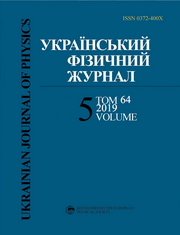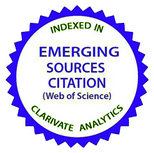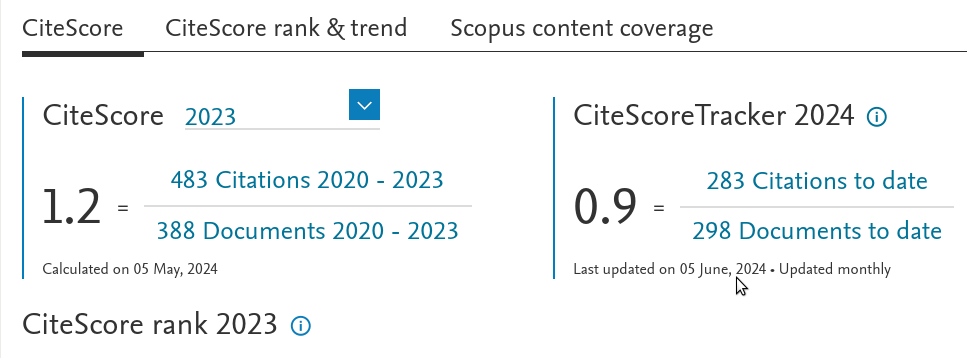Вплив потенціалів близькості на переріз реакцій синтезу 6,8He + 65Cu з гало ядрами
DOI:
https://doi.org/10.15407/ujpe64.5.363Ключові слова:
fusion cross-sections, proximity potentials, halo nucleiАнотація
Проведено повне теоретичне дослiдження потенцiалiв близькостi для найкращого опису реакцiй синтезу 6,8He + 65Cu. Використано такi рiзнi потенцiали: Prox 66, Prox 76, Prox 77, Prox 79, Prox 81-I, Prox 81-II, Prox 81-III, Prox 84, Prox 88, Mod-Prox-88, Prox 95, Prox 2003-I, Prox 2003-II, Prox 2003-III, Prox 2010, BW 91, AW 95, Bass 73, Bass 77, Bass 80, CW 76, Ngo 80 i D. Найкращi потенцiали визначенi на пiдставi порiвняння теоретичних i експериментальних даних по реакцiях 6,8He + 65Cu.
Посилання
A. Navin, V. Tripathi, Y. Blumenfeld, V. Nanal, C. Simenel, J.M. Casandjian, G. de France, R. Raabe, D. Bazin, A. Chatterjee, M. Dasgupta, S. Kailas, R.C. Lemmon, K. Mahata, R.G. Pillay, E.C. Pollacco, K. Ramachandran, M. Rejmund, A. Shrivastava, J.L. Sida, E. Tryggestad. Direct and compound reactions induced by unstable helium beams near the Coulomb barrier. Phys. Rev. C 70, 044601 (2004). https://doi.org/10.1103/PhysRevC.70.044601
A. Chatterjee, A. Navin, A. Shrivastava, S. Bhattacharyya, M. Rejmund, N. Keeley, V. Nanal, J. Nyberg, R.G. Pillay, K. Ramachandran, I. Stefan, D. Bazin, D. Beaumel, Y. Blumenfeld, G. de France, D. Gupta, M. Labiche, A. Lemasson, R. Lemmon, R. Raabe, J.A. Scarpaci, C. Simenel, C. Timis. 1n and 2n transfer with the Borromean nucleus 6He near the Coulomb barrier. Phys. Rev. Lett. 101, 032701 (2008). https://doi.org/10.1103/PhysRevLett.101.032701
A. Lemasson, A. Navin, N. Keeley, M. Rejmund, S. Bhattacharyya, A. Shrivastava, D. Bazin, D. Beaumel, Y. Blumenfeld, A. Chatterjee, D. Gupta, G. de France, B. Jacquot, M. Labiche, R. Lemmon, V. Nanal, J. Nyberg, R.G. Pillay, R. Raabe, K. Ramachandran, J.A. Scarpaci, C. Simenel, I. Stefan, C.N. Timis. Reactions with the double-Borromean nucleus 8He. Phys. Rev. C 82, 044617 (2010). https://doi.org/10.1103/PhysRevC.82.044617
F.A. Majeed, F.A. Mahdi. Quantum mechanical calculations of a fusion reaction for some selected halo systems. Ukr. J. Phys. 64, 11 (2019). https://doi.org/10.15407/ujpe64.1.11
A.A. Kulko, N.A. Demekhina, R. Kalpakchieva, N.N. Kolesnikov, V.G. Lukashik, Yu E. Penionzhkevich, D.N. Rassadov, N.K. Skobelev. Isomeric ratios for 196,198Tl and 196,198Au from fusion and transfer in the interaction of 6He with 197Au. J. Phys. G: Nucl. Part. Phys. 34, 2297 (2007). https://doi.org/10.1088/0954-3899/34/11/007
R. Wolski, I. Martel, L. Standylo, L. Acosta, J.L. Aguado, C. Angulo, R. Berjillos, J.P. Bolivar, J.A. Duenas, M.S. Golovkov, T. Keutgen, M. Mazzocco, A. Padilla, A.M. S?anchez-Ben??tez, C. Signorini, M. Romoli, K. Rusek. Sub-barrier fusion of 6He with 206Pb. Eur. Phys. J. A 47, 111 (2011). https://doi.org/10.1140/epja/i2011-11111-7
S.M. Lukyanov, Yu.E. Penionzhkevich, R.A. Astabatian, N.A. Demekhina, Z. Dlouhy, M.P. Ivanov, R. Kalpakchieva, A.A. Kulko, E.R. Markarian, V.A. Maslov, R.V. Revenko, N.K. Skobelev, V.I. Smirnov, Yu.G. Sobolev, W. Trazska, S.V. Khlebniko. Study of the 2n-evaporation channel in the 4,6He + 206,208Pb reactions. Phys. Lett. B 670, 321 (2009). https://doi.org/10.1016/j.physletb.2008.11.021
A. Lemasson, A. Shrivastava, A. Navin, M. Rejmund, N. Keeley, V. Zelevinsky, S. Bhattacharyya, A. Chatterjee, G. de France, B. Jacquot, V. Nanal, R. G. Pillay, R. Raabe, C. Schmitt. Modern Rutherford experiment: Tunneling of the most neutron-rich nucleus. Phys. Rev. Lett. 103, 232701 (2009). https://doi.org/10.1103/PhysRevLett.103.232701
V.V. Parkar, G. Marquinez, I. Martel, A.M. S?anchez-Ben??tez, L. Acosta, R. Berjillos, J. Dueсas, J.L. Flores, J.P. Bol??var, A. Padilla, M.A.G. Alvarez, D. Beaumel, M.J.G. Borge, A. Chbihi, C. Cruz, M. Cubero, J.P. Fernandez Garcia, B. Fern?andez Martнnez, J. Gomez Camacho, N. Keeley, J.A. Labrador, M. Marquis, M. Mazzocco, A. Pakou, N. Patronis, V. Pesudo, D. Pierroutsakou, R. Raabe, K. Rusek, R. Silvestri, L. Standylo, I. Strojek, N. Soic, O. Tengblad, R. Wolski, A.H. Ziad. Fusion of 8He with 206Pb around Coulomb barrier energies. EPJ Web of Conferences 17, 16009 (2011). https://doi.org/10.1051/epjconf/20111716009
G.R. Satchler, W.G. Love. Folding model potentials from realistic interactions for heavy-ion scattering. Phys. Rep. 55, 183 (1979). https://doi.org/10.1016/0370-1573(79)90081-4
J.W. Negele. The mean-field theory of nuclear structure and dynamics. Rev. Mod. Phys. 54, 913 (1982). https://doi.org/10.1103/RevModPhys.54.913
D. Vautherin, D.M. Brink. Hartree-Fock calculations with Skyrme's interaction. I. Spherical nuclei. Phys. Rev. C 5, 626 (1972). https://doi.org/10.1103/PhysRevC.5.626
K.P. Santhosh, I. Sukumaran. Alpha decay studies on Po isotopes using different versions of nuclear potentials. Eur. Phys. J. A 53, 246 (2017). https://doi.org/10.1140/epja/i2017-12446-7
R. Gharaei, V. Zanganeh. Temperature-dependent potential in cluster-decay process. Nucl. Phys. A 952, 28 (2016). https://doi.org/10.1016/j.nuclphysa.2016.04.001
K. Manimaran, M. Balasubramaniam. Deformation and orientation effects in the ternary fragmentation potential of the 4He- and 10Be-accompanied fission of the 252Cf nucleus. J. Phys. G, Nucl. Part. Phys. 37, 045104 (2010). https://doi.org/10.1088/0954-3899/37/4/045104
M Aygun. Alternative potentials analyzing the scattering cross-sections of 7,9,10,11,12,14Be isotopes from a 12C target: proximity potentials. J. Korean Phys. Soc. 73, 1255 (2018). https://doi.org/10.3938/jkps.73.1255
M Aygun. A comparison of proximity potentials in the analysis of heavy-ion elastic cross-sections. Ukr. J. Phys. 63, 881 (2018). https://doi.org/10.15407/ujpe63.10.881
M Aygun. The application of some nuclear potentials for quasielastic scattering data of the 11Li + 28Si reaction and its consequences. Turk. J. Phys. 42, 302 (2018). https://doi.org/10.3906/fiz-1801-5
M Aygun. Comparative analysis of proximity potentials to describe scattering of 13C projectile off 12C, 16O, 28Si and 208Pb nuclei. Rev. Mex. Fis. E 64, 149 (2018). https://doi.org/10.31349/RevMexFisE.64.149
J. B locki, J. Randrup, W.J. ? Swi?atecki, C.F. Tsang. Proximity forces. Ann. Phys. (NY) 105, 427 (1977). https://doi.org/10.1016/0003-4916(77)90249-4
I. Dutt, R.K. Puri. Comparison of different proximity potentials for asymmetric colliding nuclei. Phys. Rev. C 81, 064609 (2010). https://doi.org/10.1103/PhysRevC.81.064609
W.D. Myers, W.J. ? Swiatecki. Nuclear masses and deformations. Nucl. Phys. 81, 1 (1966). https://doi.org/10.1016/0029-5582(66)90639-0
P. M?oller, J.R. Nix. Macroscopic potential-energy surfaces for symmetric fission and heavy-ion reactions. Nucl. Phys. A 272, 502 (1976). https://doi.org/10.1016/0375-9474(76)90345-6
H.J. Krappe, J.R. Nix, A.J. Sierk. Unified nuclear potential for heavy-ion elastic scattering, fusion, fission, and ground-state masses and deformations. Phys. Rev. C 20, 992 (1979). https://doi.org/10.1103/PhysRevC.20.992
P. M?oller, J.R. Nix. Nuclear mass formula with a Yukawa-plus-exponential macroscopic model and a folded-Yukawa single-particle potential. Nucl. Phys. A 361, 117 (1981). https://doi.org/10.1016/0375-9474(81)90473-5
G. Royer, B. Remaud. On the fission barrier of heavy and superheavy nuclei. J. Phys. G: Nucl. Part. Phys. 10, 1541 (1984). https://doi.org/10.1088/0305-4616/10/11/010
W. Reisdorf. Heavy-ion reactions close to the Coulomb barrier. J. Phys. G, Nucl. Part. Phys. 20, 1297 (1994). https://doi.org/10.1088/0954-3899/20/9/004
R. Kumar. Effect of isospin on the fusion reaction cross section using various nuclear proximity potentials within the Wong model. Phys. Rev. C 84, 044613 (2011). https://doi.org/10.1103/PhysRevC.84.044613
P. Moller, J.R. Nix, W.D. Myers, W.J. Swiatecki. Nuclear ground-state masses and deformations. At. Data Nucl. Data Tables 59, 185 (1995). https://doi.org/10.1006/adnd.1995.1002
K. Pomorski, J. Dudek. Nuclear liquid-drop model and surface-curvature effects. Phys. Rev. C 67, 044316 (2003). https://doi.org/10.1103/PhysRevC.67.044316
I. Dutt, R.K. Puri. Role of surface energy coefficients and nuclear surface diffuseness in the fusion of heavy-ions. Phys. Rev. C 81, 047601 (2010). https://doi.org/10.1103/PhysRevC.81.047601
R. Gharaei, V.Zanganeh, N. Wang. Systematic study of proximity potentials for heavy-ion fusion cross sections. Nucl. Phys. A 979, 237 (2018). https://doi.org/10.1016/j.nuclphysa.2018.09.032
G.L. Zhang, Y.J. Yao, M.F. Guo, M. Pan, G.X. Zhang, X.X. Liu. Comparative studies for different proximity potentials applied to large cluster radioactivity of nuclei. Nucl. Phys. A 951, 86 (2016). https://doi.org/10.1016/j.nuclphysa.2016.03.039
A. Winther. Dissipation, polarization and fluctuation in grazing heavy-ion collisions and the boundary to the chaotic regime. Nucl. Phys. A 594, 203 (1995). https://doi.org/10.1016/0375-9474(95)00374-A
R. Bass. Threshold and angular momentum limit in the complete fusion of heavy ions. Phys. Lett. B 47, 139 (1973). https://doi.org/10.1016/0370-2693(73)90590-X
R. Bass. Fusion of heavy nuclei in a classical model. Nucl. Phys. A 231, 45 (1974). https://doi.org/10.1016/0375-9474(74)90292-9
R. Bass. Nucleus-nucleus potential deduced from experimental fusion cross sections. Phys. Rev. Lett. 39, 265 (1977). https://doi.org/10.1103/PhysRevLett.39.265
P.R. Christensen, A. Winther. The evidence of the ion-ion potentials from heavy ion elastic scattering. Phys. Lett. B 65, 19 (1976). https://doi.org/10.1016/0370-2693(76)90524-4
H. Ng?o, Ch. Ng?o. Calculation of the real part of the interaction potential between two heavy ions in the sudden approximation. Nucl. Phys. A 348, 140 (1980). https://doi.org/10.1016/0375-9474(80)90550-3
V.Yu. Denisov. Interaction potential between heavy ions. Phys. Lett. B 526, 315 (2002). https://doi.org/10.1016/S0370-2693(01)01513-1
G.R. Satchler. Direct Nuclear Reactions (Oxford Univ. Press, 1983).
I.J. Thompson. Coupled reaction channels calculations in nuclear physics. Computer Phys. Rep. 7, 167 (1988). https://doi.org/10.1016/0167-7977(88)90005-6
Downloads
Опубліковано
Як цитувати
Номер
Розділ
Ліцензія
Ліцензійний Договір
на використання Твору
м. Київ, Україна
Відповідальний автор та співавтори (надалі іменовані як Автор(и)) статті, яку він (вони) подають до Українського фізичного журналу, (надалі іменована як Твір) з одного боку та Інститут теоретичної фізики імені М.М. Боголюбова НАН України в особі директора (надалі – Видавець) з іншого боку уклали даний Договір про таке:
1. Предмет договору.
Автор(и) надає(ють) Видавцю безоплатно невиключні права на використання Твору (наукового, технічного або іншого характеру) на умовах, визначених цим Договором.
2. Способи використання Твору.
2.1. Автор(и) надає(ють) Видавцю право на використання Твору таким чином:
2.1.1. Використовувати Твір шляхом його видання в Українському фізичному журналі (далі – Видання) мовою оригіналу та в перекладі на англійську (погоджений Автором(ами) і Видавцем примірник Твору, прийнятого до друку, є невід’ємною частиною Ліцензійного договору).
2.1.2. Переробляти, адаптувати або іншим чином змінювати Твір за погодженням з Автором(ами).
2.1.3. Перекладати Твір у випадку, коли Твір викладений іншою мовою, ніж мова, якою передбачена публікація у Виданні.
2.2. Якщо Автор(и) виявить(лять) бажання використовувати Твір в інший спосіб, як то публікувати перекладену версію Твору (окрім випадку, зазначеного в п. 2.1.3 цього Договору); розміщувати повністю або частково в мережі Інтернет; публікувати Твір в інших, у тому числі іноземних, виданнях; включати Твір як складову частину інших збірників, антологій, енциклопедій тощо, то Автор(и) мають отримати на це письмовий дозвіл від Видавця.
3. Територія використання.
Автор(и) надає(ють) Видавцю право на використання Твору способами, зазначеними у п.п. 2.1.1–2.1.3 цього Договору, на території України, а також право на розповсюдження Твору як невід’ємної складової частини Видання на території України та інших країн шляхом передплати, продажу та безоплатної передачі третій стороні.
4. Строк, на який надаються права.
4.1. Договір є чинним з дати підписання та діє протягом усього часу функціонування Видання.
5. Застереження.
5.1. Автор(и) заявляє(ють), що:
– він/вона є автором (співавтором) Твору;
– авторські права на даний Твір не передані іншій стороні;
– даний Твір не був раніше опублікований і не буде опублікований у будь-якому іншому виданні до публікації його Видавцем (див. також п. 2.2);
– Автор(и) не порушив(ли) права інтелектуальної власності інших осіб. Якщо у Творі наведені матеріали інших осіб за виключенням випадків цитування в обсязі, виправданому науковим, інформаційним або критичним характером Твору, використання таких матеріалів здійснене Автором(ами) з дотриманням норм міжнародного законодавства і законодавства України.
6. Реквізити і підписи сторін.
Видавець: Інститут теоретичної фізики імені М.М. Боголюбова НАН України.
Адреса: м. Київ, вул. Метрологічна 14-б.
Автор: Електронний підпис від імені та за погодження всіх співавторів.

















